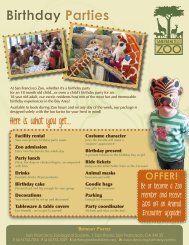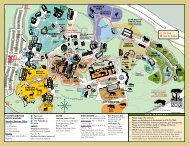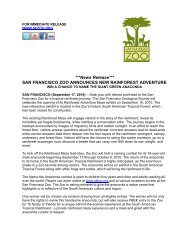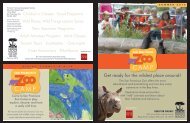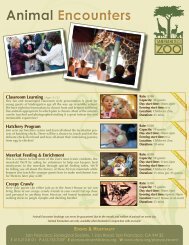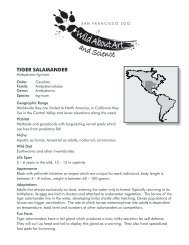Zoo Views - San Francisco Zoo
Zoo Views - San Francisco Zoo
Zoo Views - San Francisco Zoo
Create successful ePaper yourself
Turn your PDF publications into a flip-book with our unique Google optimized e-Paper software.
“As a child, I remember…my family would tell me, ‘we are going to the zoo, do not<br />
forget your zoo key,’ for I am the one in charge of keeping the zoo key. I have my first<br />
zoo key, which is red called Trunkey the Elephant from the early 1970s and when<br />
they have had different zoo keys over the years I would get another…I have kept all of my zoo<br />
keys. I remember feeding the seals fish and feeding the farm animals food that came in an ice<br />
cream cone. My grandpa’s favorite exhibit was Monkey Island. My Grandma…enjoyed going<br />
on the Zebra train with me.”<br />
— Sheryl Village<br />
VISITOR<br />
M<br />
E M O R Y<br />
In 1996, Rapunzels’ Castle, the last vestige of Storyland,<br />
was demolished and replaced with a new entrance,<br />
which included a trout stream, wetlands interpretation<br />
station and a large bronze statue of geese. In 2000, the<br />
Meerkat and Praire Dog exhibit opened, providing up<br />
close viewing of two diverse burrowing animals. By 2001,<br />
the entire Children’s <strong>Zoo</strong> was renovated under the theme<br />
of “Living with Animals”, and today includes the Family<br />
Farm, a special contact area for visitors to meet rare<br />
breeds of domestic animals; the Koret Animal Resource<br />
Center, where the animals used in the <strong>Zoo</strong>’s educational<br />
outreach programs are housed; and the Connie and Bob<br />
Lurie Education Center, which includes classrooms and the<br />
Osher Great Hall.<br />
STAFF RECOLLECTIONS…<br />
“Ah! The famous castle was imposing but cute. It was<br />
the first line of defense at the entrance of the Children’s<br />
<strong>Zoo</strong> after the fence and keepers. The kids faced a real<br />
challenge to get through; battle scars on the structure<br />
testified to the hard-fought, imaginary combats that<br />
took place there. I know, because I was the one in charge<br />
of covering the nicks and bruises with paint. It was an<br />
on-going assignment, complete with protecting my work<br />
against inquisitive little fingers. I loved it!”<br />
— Alain Duvergé - Maintainer, 23 years<br />
Storyboxes<br />
In the early 1950s, a well-known Bay Area children’s<br />
puppeteer and storyteller named Bruce Sedley grew tired<br />
of repeating his stories whenever he entertained kids. He<br />
came up with a tape-and-speaker mechanism to replace<br />
him and, by combining his skills as a storyteller, tinkerer<br />
and amateur locksmith, created the original Talking<br />
Storybook and key. Sold to zoos nationwide, the Talking<br />
Storybook was a big hit. The <strong>Zoo</strong>, an early customer,<br />
placed the renamed “storyboxes” throughout <strong>Zoo</strong> grounds<br />
with Sedley’s voice emanating fun facts about the animals<br />
and a catchy jingle that went, “All the animals at the zoo<br />
are jumping up and down for you!” The storyboxes were<br />
one of the first ways people could learn interactively. In<br />
1998, with underground construction and infrastructure<br />
replacement work taking place throughout the <strong>Zoo</strong>, the<br />
storyboxes were disconnected and some removed. In<br />
2004, the informative storyboxes returned to 20 sites<br />
around the <strong>Zoo</strong>. The original, ever-popular plastic<br />
elephant key called “Trunkey the Elephant,” whose trunk<br />
fit into the keyhole of the storybox, wouldn’t work with<br />
the new boxes, so the <strong>Zoo</strong> created new keys for a new<br />
generation to collect.<br />
Monkey Island<br />
Constructed in the 1930s<br />
as a WPA project, Monkey<br />
Island was designed as a<br />
mountain-like climbing<br />
structure for monkeys.<br />
It even had a Spanish galleon<br />
jutting out from the rockwork. When it opened in 1940,<br />
ground-dwelling rhesus macaques were housed there but<br />
in 1946, they were replaced with spider monkeys — an<br />
arboreal species. Despite the “treeless” environment, the<br />
colony thrived. Ropes, ladders, bells, and tires provided<br />
many places to swing and play and the colony grew to a<br />
stable population of 60, closely resembling the size and<br />
demographics of a wild troop. A much-beloved destination<br />
for <strong>Zoo</strong> visitors, Monkey Island became our most observed<br />
2004 <strong>Zoo</strong> agrees to provide a new home<br />
for two wild orphaned female grizzly bear<br />
siblings that were slated for euthanasia.<br />
2005 <strong>San</strong> <strong>Francisco</strong> <strong>Zoo</strong> joins U.S.<br />
Fish and Wildlife Service in effort to<br />
bring awareness to the endangered<br />
<strong>San</strong> <strong>Francisco</strong> garter snake.<br />
2005 In November, reindeer<br />
arrive for the inaugural holiday<br />
celebration – Reindeer Romp.<br />
2006 The 100th bald eagle<br />
chick hatched for reintroduction<br />
into the wild, 15 years after the<br />
<strong>Zoo</strong> hatched its first bald eagle.<br />
www.sfzoo.org 11



